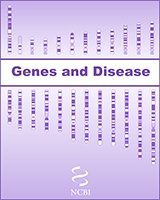NCBI Bookshelf. A service of the National Library of Medicine, National Institutes of Health.
National Center for Biotechnology Information (US). Genes and Disease [Internet]. Bethesda (MD): National Center for Biotechnology Information (US); 1998-.

Gaucher (pronounced "go-SHAY") disease is an inherited illness caused by a gene mutation. Normally, this gene is responsible for an enzyme called glucocerebrosidase that the body needs to break down a particular kind of fat called glucocerebroside. In people with Gaucher disease, the body is not able to properly produce this enzyme, and the fat can not be broken down. It then accumulates, mostly in the liver, spleen, and bone marrow. Gaucher disease can result in pain, fatigue, jaundice, bone damage, anemia, and even death.
Gaucher disease is considerably more common in the descendants of Jewish people from Eastern Europe (Ashkenazi), although individuals from any ethnic group may be affected. Among the Ashkenazi Jewish population, Gaucher disease is the most common genetic disorder, with an incidence of approximately 1 in 450 persons. In the general public, Gaucher disease affects approximately 1 in 100,000 persons. According to the National Gaucher Foundation, 2500 Americans suffer from Gaucher disease.
In 1991, enzyme replacement therapy became available as the first effective treatment for Gaucher disease. The treatment consists of a modified form of the glucocerebrosidase enzyme given intravenously. Performed on an outpatient basis, the treatment takes about 1-2 h and is given every 2 weeks. Enzyme replacement therapy can stop and often reverse the symptoms of Gaucher disease, allowing patients to enjoy a better quality of life.
- Genome view see gene locations
- Entrez Gene collection of gene-related information
- BLink related sequences in different organisms
- Research articles online full text
- Books online books section
- OMIM catalog of human genes and disorders
- GeneReviews a medical genetics resource
- National Gaucher Foundation supporting research into the causes of Gaucher disease
- Gaucher disease - Genes and DiseaseGaucher disease - Genes and Disease
Your browsing activity is empty.
Activity recording is turned off.
See more...
